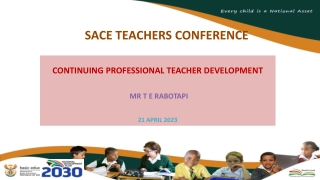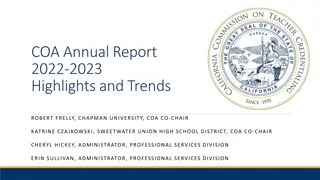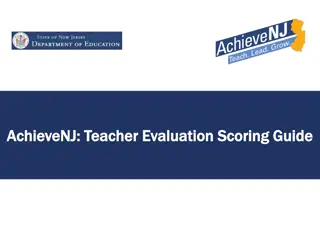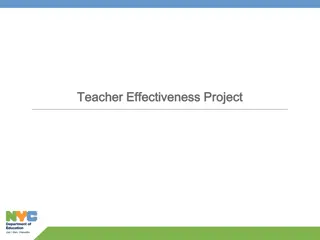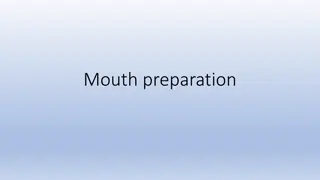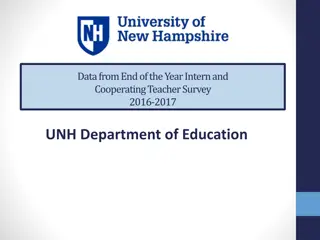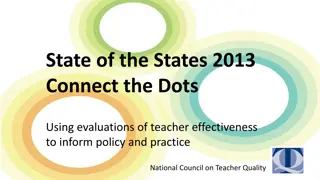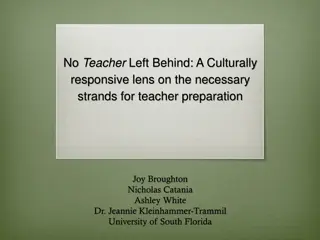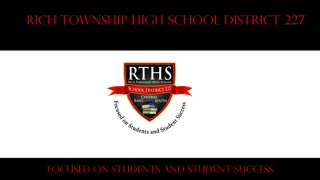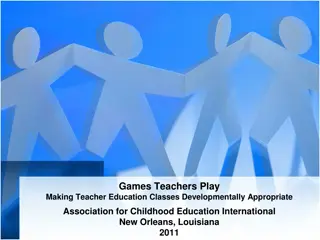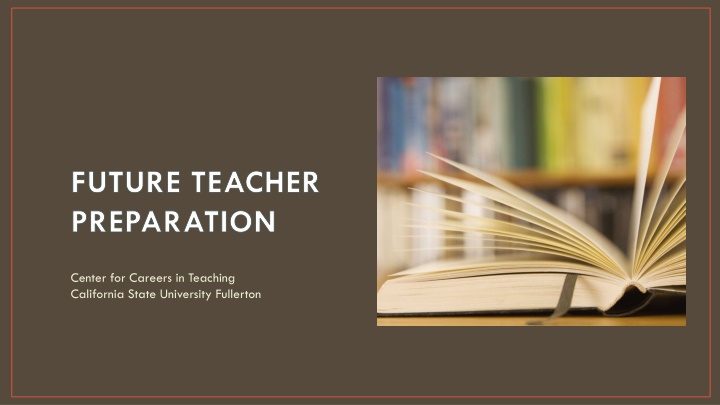
Teacher Preparation Pathway in California State University Fullerton
Explore the comprehensive pathway for future teachers at the Center for Careers in Teaching, California State University Fullerton. From Bachelor's Degree requirements to Subject Matter Pedagogy, this guide covers essential areas like building career knowledge, subject matter preparation, and student teaching to prepare aspiring educators effectively.
Download Presentation

Please find below an Image/Link to download the presentation.
The content on the website is provided AS IS for your information and personal use only. It may not be sold, licensed, or shared on other websites without obtaining consent from the author. If you encounter any issues during the download, it is possible that the publisher has removed the file from their server.
You are allowed to download the files provided on this website for personal or commercial use, subject to the condition that they are used lawfully. All files are the property of their respective owners.
The content on the website is provided AS IS for your information and personal use only. It may not be sold, licensed, or shared on other websites without obtaining consent from the author.
E N D
Presentation Transcript
FUTURE TEACHER PREPARATION Center for Careers in Teaching California State University Fullerton
Future Teacher Success Pathway Bachelor s Degree Basic Skills Requirement Subject Matter Knowledge Professional Development General Education Major focus Minor options Subject matter knowledge CBEST Other options CSET Subject Matter Preparation Program Multiple Subject Single Subject Special Education
Bachelors Degree Building Career and Content Area Knowledge
Teachers need to prepare in Subject Matter Pedagogy Foundational knowledge of curriculum area(s) Strategies and techniques of effective teaching Effective reading, writing, and critical thinking practices Student Teaching
CSU Bachelors Degree Major 36-70 units General Education 51 units Minor or Electives 18-24 units CSU Semester 120 units minimum Some degrees require more
General education courses create a foundation for future classroom content Your major should support your future curriculum area A minor or elective choices can support personal and career interests Most elective course choices should build subject matter knowledge Bachelor s Degree General Education Major Focus Minor options Subject matter knowledge
Choose a major to meet your area of expertise Elementary School Human Services Psychology Sociology Other Liberal Studies Child/Human Development
General Education recommended courses for future elementary teachers @ SAC GE Area A A.1 CMST 102 A.2 ENGL 101 A.3 Any course GE Area B B.1 ESC 115 B.2 BIOL 109/115 B.3 met B.1 B.4 Math 204 GE Area C C.1 Any C.2 ENGL 270 C.1/C.2 ENGL 231, 232, 241, 242, or ENGL/ANTH 104 GE Area D D.1-D10 HIST 101,102 or GEOG 100 D.6 US History D.8 POSC 101 GE Area E E.1 CDEV 107 9 unit minimum 9 units minimum, 12 units preferred 9 unit minimum 9 units minimum 3 unit minimum All courses included on the Associate Degree for Transfer in Elementary Education
Choose a major to suit your area of expertise: Middle/High School Math Science Biology Chemistry Physics Geological Science Social Science History Geography Economics Political Science Criminal Justice Anthropology American Studies Art English Music Kinesiology Foreign Language
General Education recommended courses for future social science teachers @ SAC World History US History Political Science Economics Geography Education HIST 101 HIST 102 HIST 120 HIST 121 POLT 101 ECON 120 ECON 121 GEOG 100 EDUC 210 EDUC 204 Courses selected to meet the subject matter preparation pathway for Social Science content and competencies.
Basic Skills Requirement Foundational classroom skills
Examination English Score Requirement Math Score Requirement CBEST Reading, Writing, and Math sections A score of 41 per section/ 123 score overall Basic Skills Requirement CSET Writing Skills 220 passing score CSU Early Assessment Program (EAP) CollegeReady or Exempt CollegeReady or Exempt CBEST Other options CSU Placement Exams (EPT and ELM) Score of 151 or above Score of 50 or above College Board SAT Score of 500 or above Score of 550 or above ACT Score of 22 or above Score of 23 or above College Board Advanced Placement Examinations (AP) Score of 3 or above on one of the following: AP English Language and Composition AP English Literature and Composition Score of 3 or above on one of the following: AP Calculus AB AP Calculus BC AP Statistics
CBEST California Basic Educational Skills Test What is it? The CBEST is the California Basic Educational Skills Test is designed to test basic reading, mathematics, and writing skills found to be important for the job of an educator. Who is it for? Anyone who wants to substitute teach or desires a career as a classroom teacher must pass the CBEST or its equivalent.
When is the CBEST offered? Paper-based testing ($41)is offered five to six times during the year. In 2016-2017, you can take the CBEST in the following months: September, December, February, April, and July. Computer- based testing ($41+ $61)is available year-round by appointment only, Monday through Saturday (excluding holidays).
Subject Matter Knowledge Demonstrating Subject Area Expertise
California Subject Exam for Teachers: a state sanctioned assessment on core curriculum subject matter Subject Matter Knowledge CSET Subject Matter Preparation Program Subject Matter Preparation Program : an approved selection of courses that comprehensively covers subject area in depth; usually embedded in a major but may require additional courses.
Subject matter knowledge & competency All teachers need to demonstrate a specific set of knowledge, skills, and/or abilities reflecting the subject taught: o For future elementary school teachers this is done by passing the Multiple Subject CSET test. o For future middle/high school teachers this is done by passing the CSET in your area of curriculum specialty or complete a state-approved subject matter preparation program (SMPP)
Subject matter knowledge - multiple subjects for elementary CSET: Multiple Subject One comprehensive exam three subtests Reading, Language, and Literature / History and Social Science Science (Earth, Physical, Life) and Mathematics Physical Education, Human Development, Visual and Performing Arts
Subject matter knowledge Single subject area for junior high/high school CSET: Mathematics One comprehensive exam three subtests Number Quantity, Algebra Geometry, Probability and Statistics Calculus
Subject matter preparation programs Teacher candidates in California are required to demonstrate competence in the subject matter they will be authorized to teach. Candidates for the single subject credential have two options available for satisfying this requirement. They can either complete a commission-approved undergraduate subject matter preparation program or they can pass the appropriate commission-adopted subject matter examination(s). Undergraduate degree Subject Matter Preparation Program (SMPP)
Professional Development Credential Programs
Professional Development Multiple Subject authorization for the TK-8th grade classroom Single Subject authorization for the 7th -12th grade classroom Special Education authorization for TK-12th classroom based on disability specialty Multiple Subject Single Subject Special Education
What is a credential program? Traditionally , a two semester program following the Bachelor s degree; sometimes referred to as a 5th year program. Includes student teaching PEDOGOGY! Credential programs teach the methodology and practical applications of how to be a teacher
Steps to a credential program Obtain a bachelor s degree Prove knowledge of basic skills CBEST: California Basic Educational Skills Test Prove subject matter competency CSET: California Subject Examinations for Teachers SMPP: Subject Matter Preparation Program (single subject only) Complete a course in the provisions and principles of the U.S. Constitution or pass an examination given by a regionally-accredited college or university. Complete any prerequisites and fieldwork.
What Does a Multiple Subject Credential Authorize You to Teach? The Multiple Subject teaching credential authorizes the holder to teach all subjects in a self-contained classroom, such as the classrooms in most elementary schools.
What Does a Single Subject Credential Authorize You to Teach? The Single Subject teaching credential authorizes the holder to teach the specific subject(s) named on the credential in departmentalized classes, such as those in most middle schools and high schools.
What Does a Education Specialist Credential Authorize You to Teach? Credentials in mild/moderate and moderate/severe disabilities authorize the provision of services to individuals in grades K through 12, and in classes organized for adults. Early childhood special education includes the provision of educational services to children from birth through pre-kindergarten who are eligible for early intervention, special education, and/or related services under federal and state laws.
Credential Program Preparation Check with the universities you are interested in attending to see what are their specific prerequisites as they vary from school to school. Some universities offer blended programs where you can earn your bachelor s degree and teaching credential at the same time. Others may offer blended programs where you earn your teaching credential and master s degree at the same time. Many universities offer their credential programs as a 5th year program completed the year after the bachelor s degree.
Choosing the Right Program for You Considerations: -Cohort vs. Non-cohort -Cost -Combined bachelor s degree and credential Post-baccalaureate course work recognition -Combined credential and master s program The myth: districts won t hire with a master s Master s degree as professional development Personal & professional opportunity
Cohort v. Non-cohort Credential Programs Just like degree programs are structured differently from university to university, so are credential programs! Some universities have structured their multiple subject and single subject credential programs to follow a cohort format: A cohort is a learning community in which all classes for the credential program contain the same students each semester. Each semester is specifically structured, the classes are arranged in a particular format, and you are guaranteed that you will be able to register for all of your classes.
Cohort v. Non-cohort Credential Programs Cohort Non-Cohort Guaranteed course enrollment and timely completion Strong relationships with faculty and other students Limited flexibility Limits ability to work No guarantee of course enrollment Flexibility of course load Flexibility to work Program completion time varies
Credentialing Costs Cost is an important factor when deciding on a credential program For academic year 2016-2017 $3720 (sem.) / $7440 @ CSUF (2 semesters) $3668 (sem.) / $7336 @ CSULB (2 semesters) $2642 (quar.) / $7926 @ Cal Poly Pomona (3 quar.) $5661 (quar.) / $22,644* @ UCI (4-5 quar.) w/ MAT 41credits@$875 per credit / $35,875 (18mos.) Chapman University w/MAT add 12 units - $10,500
Teacher Salaries 2016-2017 Degree + Recognized graduate level units Placentia Yorba Linda School District Fullerton School District Anaheim Elementary School District Santa Ana Unified Garden Grove Unified BA 50,944 53, 857 44,188 46, 918 (+15) 56,826 57,278 BA + 30 53,348 53,857 49,659 56,826 (+24) (step 1-3) 57,542 BA + 45 57, 618 55,547 52, 380 56,826 57,548 (step 2) 60,738 BA + 60 62, 226 58,852 55, 110 58,391 63, 935
High Need Areas in Education K-12 STEM education President Obama is calling for 100,000 Math and Science teachers in the next 10 years. Foundational Level Math teacher Teaches Math through Algebra II. Math teacher Teaches Math through Calculus. Foundational Level Science teacher Teaches middle and high school integrated science concepts. Biology, Chemistry, Physics, Geological Science teacher Teaches 9-12 grade science in their area of specialty.
Math Education credentials Foundational Level Math Math Allows one to teach general mathematics, Algebra, Geometry, and Probability and Statistics Allows one to teach all areas of FLM and AP courses, Trigonometry, Pre-Calculus and Calculus courses
Science Education credentials Foundational Level Science Science Allows one to teach introductory and general science, introductory life science, introductory physical science and integrated science through grade 8. Allows one to teach all areas of the FLGS and specific core discipline in 9th-12th grade Biology, Chemistry, Geology, and/or Physics.
Special Education Mild/Moderate Disabilities (M/M) Includes specific learning disabilities; mild to moderate intellectual disabilities; other health impairments; serious emotional disturbance; and authorizes service in grades K 12 and in classes organized primarily for adults through age 22. Moderate/Severe Disabilities (M/S) Includes autism; deaf-blindness; moderate to severe intellectual disabilities; multiple disabilities; serious emotional disturbance; and authorizes service in grades K 12 and in classes organized primarily for adults through age 22. Deaf and Hard of Hearing (DHH) Includes deafness; hearing impairment; deaf-blindness; and authorizes service to individuals ages birth through 22. Visual Impairments (VI) Includes blindness; visual impairment; deaf-blindness; and authorizes service to individuals ages birth through 22.
Special Education Physical and Health Impairments (PHI) Includes orthopedic impairment; other health impairment; multiple disabilities; traumatic brain injury; and authorizes service to individuals ages birth through 22. Early Childhood Special Education (ECSE) Includes the mild/moderate and moderate/severe disabilities listed above and traumatic brain injury; authorizes service to children ages birth to pre-kindergarten only. Language and Academic Development (LAD) Authorizes the holder to provide instructional services to students with academic communication and language needs to children in preschool, kindergarten, in grades 1 - 12 through age 22, and classes organized primarily for adults, but does not take the place of speech and language services as defined in Education Code section 56333
Student Organizations Student California Teachers Association (SCTA) Dedicated to supporting persons who want to become educators. Benefits include liability coverage while student teaching.
Financial Aid Opportunities Direct loans and Federal Stafford loan Forgive $5000-$17500: www.Federalstudentaid.Ed.Gov/tc Loan cancellation program Federal Perkins loans: may cancel up to 100% of loan www.Federalstudentaid.Ed.Gov/tc TEACH grant (Teacher Education Assistance for College and Higher education) https://studentaid.ed.gov/sa/types/grants-scholarships/teach - K-12 public/private school - May be awarded up to $4,000/yr. - Full-time teacher in high need field and low-income area for 4 academic years (within 8 years of graduating)
Caren Bautista California State University, Fullerton cbautista@fullerton.edu



